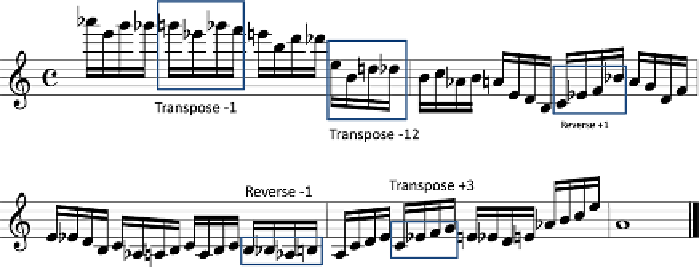Information Technology Reference
In-Depth Information
Fig. 5.22
A chorus generated on an
A minor
sequence. Formal transforms are triggered randomly
during the chorus, as indicated. Note, and hear, the smooth landings on the A minor key following
the transforms, in particular the striking effect produced by the third transform (reverse-1)
as the licks in 4 as training phrases for the corresponding scale (D minor) would
blur the very notion of harmony, as notes from the side-slips would be considered
as equivalent to notes from the original key. Furthermore, such an approach would
require a tremendous amount of training data (for each possible pattern, and each
possible side-slip). More importantly, it would then be impossible to trigger
inten-
tionally
decisions to produce, or not, these side-slips.
5.5.2 The Control Issue
Above all, virtuosos can be seen as exceptional humans in the sense that they seem
to exert
full control
on their production. The control issue is both the most difficult
and the most interesting one to handle.
We can state the control problem as follows: how to generate a sequence that
fits an arbitrary criteria, defined by target properties of the next generated phrase?
In our context, such properties can be defined in terms of phrase features such as:
pitch (go 'higher' or 'lower'), harmonic constraints ('more tonal notes'), intervals
(chromatic), direction (ascending, descending),
arpeggiosity
, etc. Allowing such a
level of control in our system is key to producing phrases with musically meaningful
intentions.
The difficulty in our case comes from the fact that the generator operates on
a note-by-note basis, whereas most criteria useful in practice operate on complete
phrases. Let us suppose, for instance, that we want the next generated phrase to be
'higher' in pitch than the current one. It does not suffice to simply choose, at the
note level, the next note with the higher pitch. Such a policy has been proposed in
(Pachet
2003
), and works well for simple harmonisation tasks, but not here, as we
want the pitch criteria to hold on an entire next phrase. For instance, a good strategy
could consist in first choosing a lower pitch and then playing an ascending arpeggio.
So
longer-term planning
is needed to find satisfying, let alone optimal, phrases.

